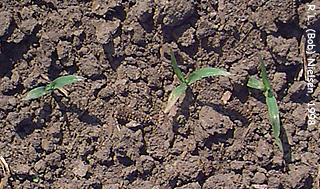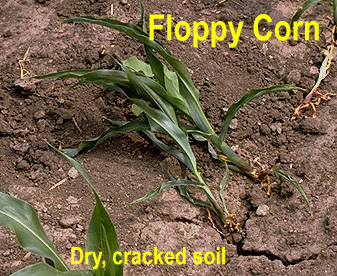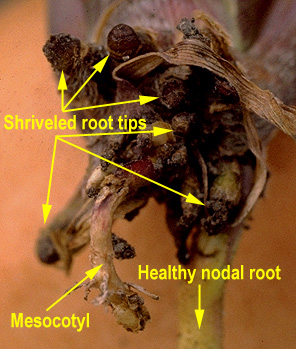Originally published in the Chat 'n Chew
Café (15 May 1998)
Be Alert For Floppy Corn
R.L. (Bob) Nielsen ,
Agronomy Department ,
Purdue University, West Lafayette, IN
47907-1150
Internet address: rnielsen@purdue.edu

The recent change in the weather pattern in Indiana from excessively wet
to unusually warm and dry has resulted in the development of a substantial
crust in fields that were previously worked and planted in late April.
Obviously, a thick crust can restrict the emergence of corn and cause
underground leafing. The rapid drying of the upper soil layer is also
conducive for the development of the "floppy corn" syndrome.
My accompanying article, " A
Primer on Corn Root Development", briefly describes the normal
development of a corn seedling's root systems. Root buds from any given
node that begin to elongate in dry soil or in soil cracks may quickly
cease growth if soil moisture is insufficient. Without adequate soil
moisture, the root tips may dessicate and die. If the soil remains dry
long enough, the whole root bud may die. At this point, the plant's
survival depends on improved soil moisture conditions and the development
of the next set of nodal roots.
 If
dry surface soil and/or hot, dry weather prevail, several sets of nodal
roots may fail to form, giving rise to the "rootless corn"
phenomenon. Affected plants must depend on the seminal roots and mesocotyl
for nourishment, when normally this lifeline has already taken a backseat
to the nodal root system.
If
dry surface soil and/or hot, dry weather prevail, several sets of nodal
roots may fail to form, giving rise to the "rootless corn"
phenomenon. Affected plants must depend on the seminal roots and mesocotyl
for nourishment, when normally this lifeline has already taken a backseat
to the nodal root system.
In addition to the nutrient stress imposed on the plants by an
inadequate nodal root system, the rootless phenomenon can eventually
result in the floppy corn syndrome, whereby plants simply ‘flop’
over at the soil surface at the slightest nudge from wind, tire traffic or
even crop scouts walking down the row.
These plants are technically not root-lodged, they are simply broken
over at the base of the stem near the crown area. The nodal roots will
appear stubbed off but not eaten. The root tips will be dry and shriveled.
 These
symptoms are unlike any associated with herbicide injury or insect
feeding. Because several sets of roots may not have formed below-ground,
the crown may "appear" to be at or above the surface.
These
symptoms are unlike any associated with herbicide injury or insect
feeding. Because several sets of roots may not have formed below-ground,
the crown may "appear" to be at or above the surface.
The important thing to remember is that roots do not grow toward
moisture on purpose. If the root tips of very young roots die before soil
moisture is encountered, root elongation will simply cease. If roots are
already in moist soil, however, they may proliferate rapidly enough to "follow"
moisture down as the soil dries. Row cultivation may encourage root
development if moist soil is thrown around the bases of the plants. The
ultimate solution to the problem is a good soaking rain.
Useful Reminder:
‘Rootless’ corn can also be caused from extremely shallow
seeding depths that result in nodal root initiation beginning at the soil
surface rather than at the usual ¾ inch depth. Growers should avoid
seed depths shallower than about 1 to 1½ inches.

For other information about corn, take a look at
the Corn Growers Guidebook on the World Wide Web at
http://www.agry.purdue.edu/ext/corn/
End of Document
 If
dry surface soil and/or hot, dry weather prevail, several sets of nodal
roots may fail to form, giving rise to the "rootless corn"
phenomenon. Affected plants must depend on the seminal roots and mesocotyl
for nourishment, when normally this lifeline has already taken a backseat
to the nodal root system.
If
dry surface soil and/or hot, dry weather prevail, several sets of nodal
roots may fail to form, giving rise to the "rootless corn"
phenomenon. Affected plants must depend on the seminal roots and mesocotyl
for nourishment, when normally this lifeline has already taken a backseat
to the nodal root system.
 These
symptoms are unlike any associated with herbicide injury or insect
feeding. Because several sets of roots may not have formed below-ground,
the crown may "appear" to be at or above the surface.
These
symptoms are unlike any associated with herbicide injury or insect
feeding. Because several sets of roots may not have formed below-ground,
the crown may "appear" to be at or above the surface.